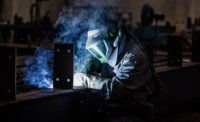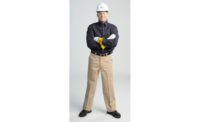In most countries, hearing protectors are required by law to be tested and labeled in a specific way. The idea is that by using a standardized measurement method and a straightforward, one-number rating, it should help users decide which hearing protector to choose. However, it turns that one number often doesn’t tell the whole story.
What is NRR?
Hearing protectors sold in the U.S. must be labeled with a Noise Reduction Rating (NRR). The NRR is often a significant factor in purchasing hearing protectors and estimating at-the-ear noise exposures.
The NRR is derived from measurements done on ten subjects in an acoustic chamber. First, the subjects’ hearing is tested without hearing protectors. Next, the subjects are fitted with the hearing protector, and then their hearing is tested again. This procedure is repeated three times per person. The amount of change in their hearing, caused by wearing hearing protectors, is used to calculate the NRR.
Hearing conservation regulations tell us how to use the NRR, but research has revealed that the NRR may not always predict the amount of noise reduction an individual worker receives. Recent research has shown that some workers may not get as much noise reduction as indicated by the NRR. Sometimes hearing protectors aren’t used correctly and sometimes they simply don’t fit a particular person well. A 2015 study by NIOSH discovered that 40% of workers were not getting sufficient attenuation on an initial fit test.[i]
U.S. regulations state that employees must be allowed to select from a variety of suitable hearing protectors. First, employers should use the NRR to calculate whether the hearing protector can provide enough reduction for the noisy environment. To do this, the employer must know the NRR and the workplace noise exposures. Next, employers must ensure the proper initial fit of the hearing protectors.
What is a PAR?
Fortunately, today we can easily learn about the noise reduction of a hearing protector on the actual worker. Hearing protector fit testing measures the amount of attenuation a hearing protector provides on each ear, on each person. This real-world measurement is a Personal Attenuation Rating or PAR. Why is PAR important?
Each person has unique ear canals—that’s why there can be a large range in attenuation achieved by individuals in the workplace using the same model of hearing protector. Even if you give everyone a high NRR earplug, you should expect they won't all receive the same attenuation. Plus, there’s the issue of inserting hearing protectors properly. One study found that out of 327 experienced users tested, 30% were not properly protected—putting them at risk of noise-induced hearing loss (NIHL). The study also found that 17% had to be retrained before achieving an adequate fit. Without fit testing and training, those workers were at increased risk of suffering NIHL.[ii]
The Importance of Fit Testing
The positives are clear—fit-testing can help enhance your hearing conservation program. Reducing
incidents of noise-induced hearing loss not only saves money in the long run—it saves people’s hearing. Remember, hearing loss is preventable, but it is not reversible once it occurs.
However, not all fit-test systems are equal. Fit-test systems use either objective or subjective methods to assess attenuation and each may have a different method of measuring and calculating PAR. This potential for variance demonstrates the need for standardization.
Understanding the Benefits of the New ANSI/ASA Fit Testing Standard
ANSI/ASA has now published the first standard setting the criteria that fit-test systems should meet to improve accuracy and reporting of fit-test results. This new ANSI/ASA S12.71-2018 standard provides quality requirements for fit-test systems. Compliance with this standard promotes greater accuracy and transparency in reporting results.
Evidence shows that use of fit testing can help identify workers who may be at risk of developing NIHL. If you are not fit-testing your workers, adopting a compliant fit-test system can help you quickly identify workers at risk of under protection, help select appropriate hearing protection for them, and provide effective training.
What’s behind the numbers? Start with the NRR to offer hearing protectors with enough noise reduction for the work exposure. Follow-up with an individual fit test and ensure that the hearing protector and the PAR are right for the worker and the noise.
Learn more about Hearing Conservation Solutions
- [1] Berger EH, Franks JR, Behar A, Casali JG, Dixon-Ernst C, Kieper RW, Merry CJ, Mozo BT, Nixon CW, Ohlin D, Royster JD, Royster LH. J Acoust Soc Am. 1998 Feb; 103(2):665-72. “Development of a new standard laboratory protocol for estimating the field attenuation of hearing protection devices. Part III. The validity of using subject-fit data.” https://asa.scitation.org/doi/abs/10.1121/1.423236
- [1] 3M Technical Bulletin, 3M™ E-A-Rfit™ Validation System Assists to Train and Maintain Proper Use of Hearing Protection Over Time. 2018. https://multimedia.3m.com/mws/media/1103559O/whitepaper-e-a-rfit-results-ata-327-person-account.pdf


